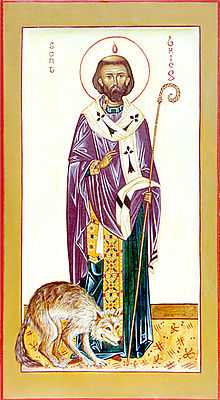Saint Brioc
| Saint Brioc | |
|---|---|
 | |
| Abbot | |
| Born |
5th century Ceredigion, Wales |
| Died |
c. 502 St Brieuc-des-Vaux, Brittany |
| Venerated in |
Roman Catholic Church, Eastern Orthodox Church, Anglican Communion |
| Major shrine | St Brieuc-des-Vaux |
| Feast | 1 May |
Saint Brioc (Breton:Brieg; Welsh: Briog; Cornish: Breock; French: Brieuc; died c. 502) was a 5th-century Welsh holy man who became the first abbot of Saint-Brieuc in Brittany.[1] He is one of the seven founder saints of Brittany.[2]
Life
Very little is known about Brioc's early life, as his 9th century Acta is not altogether reliable. It states that he came from Ceredigion where, indeed, he has a church at Llandyfriog. He received his education in Ireland and then studied under Germanus of Auxerre. He most likely returned to France early in 431, accompanied by Saint Illtud.[1]
In 480, he settled in Armorica, and founded a monastery at Landebaeron. He then traveled to Upper Brittany where he established an oratory at St Brieuc-des-Vaux, between St. Malo and Land Triguier, where he eventually became the abbot of a monastery.[1]
Authorities differ as to date of Saint Brioc's death, but it was probably in 502, or in the early years of the sixth century. He died in his own monastery at St. Brieuc-des-Vaux and was interred in his cathedral church, dedicated to Saint Stephen.
Veneration
His Acta cites numerous miracles, especially his cure of Count Riguel, who gave the saint his own Palace of Champ-du-Rouvre as also the whole manorial estates.[1] He is represented as treading on a dragon or presented with a column of fire as seen at his ordination.
Saint Brioc's relics were moved to the Church of Saints Sergius and Bacchus of Angers in 865, and again, in a more solemn manner, on 31 July 1166. However, in 1210, a portion of the relics was restored to St. Brieuc Cathedral, where the saint's ring is also preserved.[1]
His feast day is 1 May. The festival of Saint Brioc was celebrated on 1 May, but in 1804, the festival has been held on the second Sunday after Easter. Churches in England, Ireland, and Scotland are dedicated to this early Celtic saint,[1] including the parish church of St Breock in Cornwall.[3]
See also
- List of Catholic saints
- Blessed Julian Maunoir, "Apostle of Brittany"
- Breage, reputed founder of Breage, Cornwall
References
- ↑ 1.0 1.1 1.2 1.3 1.4 1.5 Grattan-Flood, William. "St. Brieuc." The Catholic Encyclopedia. Vol. 2. New York: Robert Appleton Company, 1907. 19 Jan. 2014
- ↑ Mooney, Ambrose. "St. Brioc the Traveller, Bishop of Brittany". Celtic Saints. Retrieved 28 April 2013.
- ↑ Cornish Church Guide (1925) Truro: Blackford; p. 64
![]() This article incorporates text from a publication now in the public domain: Herbermann, Charles, ed. (1913). Catholic Encyclopedia. Robert Appleton Company.
This article incorporates text from a publication now in the public domain: Herbermann, Charles, ed. (1913). Catholic Encyclopedia. Robert Appleton Company.